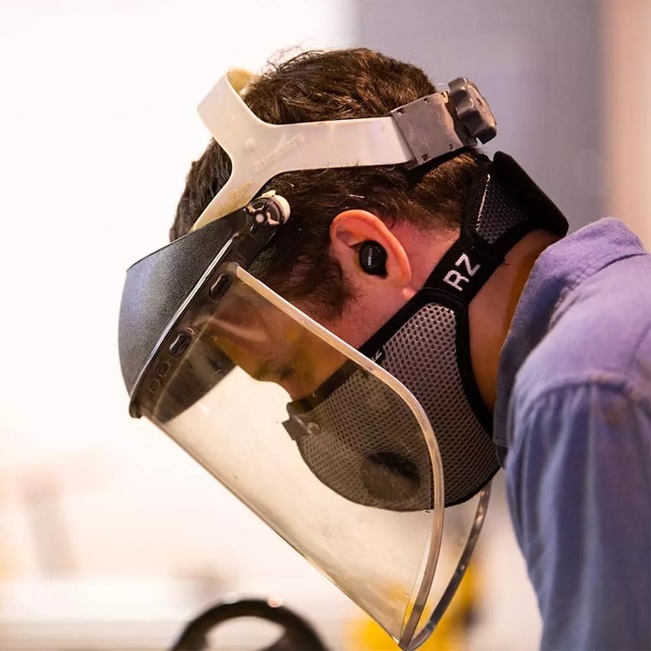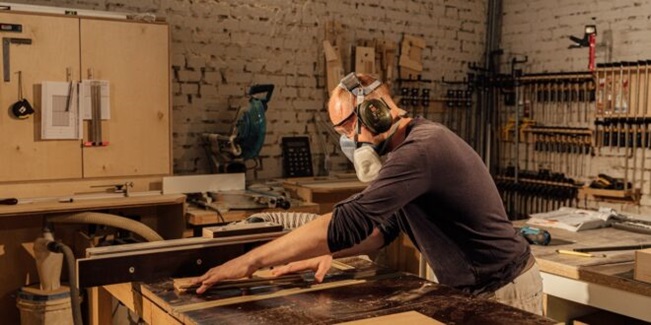Woodworking is a much-respected profession and a popular hobby. It requires dedication, patience, and attention to detail to create wooden items you’ll be proud of. It’s important to have all the right, high-quality pieces of materials and tools, but it’s even more important to have reliable personal protective equipment for every step of the project.
Understanding the potential dangers associated with woodworking, such as flying debris, power tool mishaps and more, can help you take the necessary precautions to protect yourself and others involved in the process. The use of various materials, tools, and chemicals in the workshop may pose health risks if not handled properly. Sawdust and wood particles can cause respiratory issues, while exposure to certain chemicals in adhesives and wood finishes can lead to skin irritation.
Prioritising safety is essential for enjoying a long and healthy wood crafting journey. To begin with, buy personal protective equipment and ensure that your experience, whether professional or DIY, is safe. To help you narrow down your options, here are some of the must-have pieces and what you need to know about them before making a purchase.
Essential PPE in Woodworking: Create a Safe Working Environment

PPE is any special clothing or equipment that protects workers from physical hazards in the workplace. It includes various items that can help you protect yourself from potential dangers on the job, and for those in the woodworking industry, the following are some of the most common types.
Hearing Protection
Ear protection is critical when working with loud machinery, whether it’s a saw, drills, or else. Wearing the proper earmuffs can help prevent long-term hearing damage from occurring due to prolonged exposure to noise. Make sure they’re comfortable and easy to use. Hearing protection is not needed when woodturning, where noise levels are minimal.
Eyewear Protection
Woodworking involves cutting, shaping, and sanding materials and all of these processes produce flying debris. Protective eyewear is the no.1 solution for preventing potentially blinding injuries. Wearing appropriate eye protection such as safety glasses or goggles can shield your eyes and optimise comfort and performance. Choose a pair with impact-resistant lenses to keep your eyes safe from flying debris, wood particles and other hazards.
Respiratory Protection
It’s been proven that sawdust poses major long-term health risks and a dust mask is needed to filter out the dust particles we can’t see. A good dust mask should have replaceable filters and filter out more than 95% of particles down to 0.3 micrometres.
But sawdust is not the only airborne danger in the woodworking environment. Many finishes contain volatile organic compounds that can pose health risks, too, and to protect yourself you can use a respirator that creates a good seal around your face to protect yourself. Keep in mind that it’s important to work in a well-ventilated area as adequate ventilation in the workshop can help improve air quality and prevent the build-up of hazardous substances.
Skin Contact Protection
When using adhesives, solvents, and finishing products in your workshop, you can use brushes, application sticks and other non-contact methods. However, it’s always a good idea to wear proper protective gloves to avoid any potential contact with the chemicals. Nearly every manufacturer recommends avoiding skin contact in the safe use instructions on the product labels. Also, make sure to regularly inspect tools and materials for defects such as cracks, nails, or splinters and remove them if there are any before use.
First Aid Kit
Last but not least, always keep a fully stocked first aid kit at hand. It needs to be easily accessible and equipped with bandages, gauze tweezers, alcohol spray, antibacterial ointment, cold compression bags, and exam gloves. And if you don’t know yet, then it’s time to learn how and when to use everything in there before you need to.
A Few Additional Tips

Avoid wearing loose-hanging clothing and jewellery as anything that hangs far from your body is potentially dangerous as it could get caught in a spinning blade. Also, remove all tripping hazards and keep your workshop’s floor tidy and clean at all times. Move low objects out of the way and tape down loose cords. And of course, always wear sturdy boots.
When it comes to clothing, wearing long-sleeved shirts and pants can protect your body from cuts, abrasions, and exposure to chemicals. A durable, expertly crafted woodworking apron can be useful, too, especially if it comes with pockets, hammer loops and holders to hold your tools conveniently.
Remember that focus and awareness are crucial for staying safe while woodworking. Pay attention to what you’re doing, understand the basics of safe operation and each one of the tools you’re using. Stay in the moment and enjoy every step of the process fully. If you feel distracted, take a break and go back to your work with a clear mind.
Final Thoughts
By understanding the importance of wearing personal protective gear in your workshop, knowing the different types available, and following proper usage and maintenance guidelines, you can enhance both safety and performance. Also, it allows you to set a positive example for others, including fellow woodworkers, family members, or apprentices. Prioritising safety in your woodworking practice demonstrates responsibility and care for yourself, the people around you and your crafts.
























